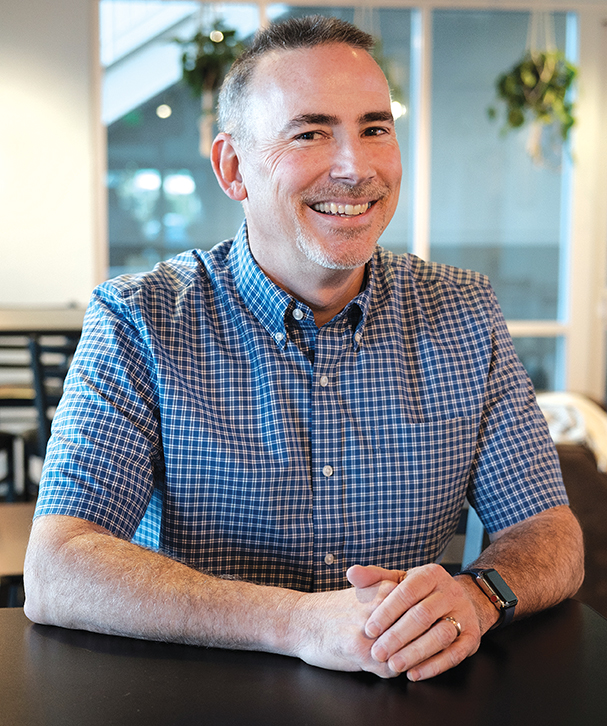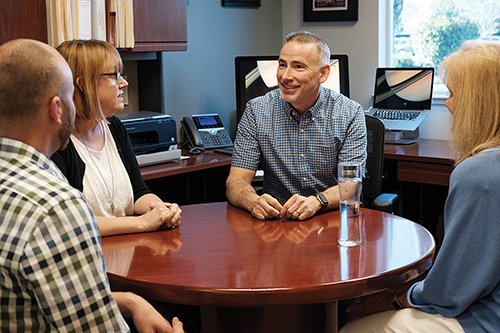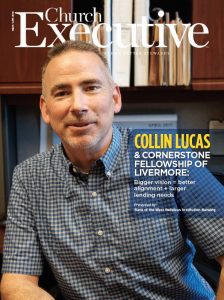
![]()
By RaeAnn Slaybaugh
Sixteen years ago, when Collin Lucas joined the staff at Cornerstone Fellowship of Livermore, he worked in IT. However, he also brought with him extensive experience in the business management consulting realm.
Now, as Cornerstone’s CFO, his secular business background has proven instrumental in helping build — and fund intelligently — the church’s rapidly expanding infrastructure.
When Collin Lucas came onboard at Cornerstone in 2002, the church was operating on a “mega-campus” model in Livermore, Calif. Growth in that vein continued for several years, with funding assistance from a long-time church lending partner.
Though a second location was launched in nearby Brentwood, Calif., in 2008, leaders continued to focus on building up the Livermore campus. It made sense: the congregation was growing, parking needs increased, and a bigger auditorium was being considered. The church purchased 10 acres of adjacent land with the mindset of, as Lucas puts it, “Let’s build this.”
This expansion was a fairly straightforward proposition for their lending partner.
But then, plans changed
In 2011, Cornerstone’s executive pastor John Gilpin shared a book — Simple Church by Thom S. Rainer and Eric Geiger — with Lead Pastor Steve Madsen. It was a game-changer.
“We really began to question what is most important to us and what we should be focusing on as a church,” Lucas recalls. “It’s one thing to get big — but what was our purpose and goals, what was our mission?”
Lucas likens the shift in vision to the difference between In-N-Out Burger and The Cheesecake Factory. “Both are great restaurants, but they’re trying to achieve different things,” he says. “One does everything under the sun, in terms of its menu. I would say that’s probably where Cornerstone landed at the time; we were trying to do a lot of different things.”

But, leaders really wanted to simplify. To be more like In-N-Out Burger, in other words.
“We said, ‘You know what? Our goal is to make disciples. And if we’re going to make disciples, what’s the best way to do that?’ We want to make sure what we do causes people to grow in their relationship with Christ.”
So, in 2012 — with clarity and focus and on what to do moving forward — leaders began to pursue how to operate as a church with two campuses. They attended training and conferences. They met with multisite experts, including Jim Tomberlin — author, founder and CEO of MultiSite Solutions, and pioneer of the multisite model at Willow Creek Community Church in Chicago — and Kevin Penry, a multisite specialist at MultiSite Solutions, who served as pastor, operations leader and member of the Directional Leadership Team at Life.Church in Edmond, Okla., until his retirement in 2016.
Through their research, the Cornerstone leadership team learned that the success rate of a multisite church, versus a church plant, was about 80% to 20%, respectively, at the end of five years.
“It all just helped us to realize we could probably do a better job in accomplishing our mission if we didn’t have just one big campus,” Lucas recalls. “They talked a lot about how to couple operating as a multisite church with the whole idea of simplifying what we do, of focusing, of having clarity of vision, alignment and movement. After that, we said, ‘OK, maybe being a mega-site church is not the best thing for us to do.’”
They began asking questions.
What if, rather than making people drive an hour to come to church, we go into their communities and put campuses there?
Would that enable them to develop community? Develop relationships?
Bigger vision = better alignment + larger lending needs
Lucas’ business management background lent itself well to helping drive this significant change on the horizon at Cornerstone. He knew that the church would have to align under a common vision, the people and resources would need be aligned, and that everything about the church would need to align underneath a sharpened purpose, vision and direction.
“Obviously, it wasn’t just me,” he points out. “It was a group recognizing the fact that a rapidly growing church needs to have an adequate infrastructure to be able to support its staff and congregation well. I personally credit Lead Pastor Steve Madsen, John Gilpin — our church’s then-executive pastor and current vice chairman of the board — and our current executive pastor, Chris Stockhaus, for leading the way.”

Collectively, they also knew this meant the church would need to fund that infrastructure.
Until that point, Cornerstone had worked with only one lender. It was a good relationship; even so, their lender recognized that it couldn’t accommodate the future vision, plans and the accelerated growth of the ministry under its current trajectory. As such, the existing lender recognized the church had outgrown their lending capacity.
In 2014, Lucas and his fellow leaders at Cornerstone were introduced to Bank of the West by way of Brad Leeper, President and Principal at Generis. “We began talking, and they really opened up and said, ‘We love what you’re doing. How can we help?’” Lucas recalls. “We really sensed, I think, that this wasn’t just ‘a bank.’ This was somebody who not only cared about what we were doing and the direction we were going, but liked the direction and wanted to help.”
Lucas and the rest of the Cornerstone team now work closely with David S. Lee, who serves as Vice President, Religious Institution Banking at Bank of the West. That relationship was particularly easy to forge, as Lee had also worked for Cornerstone’s previous, long-time lender!
“I’ve worked with two of the largest lenders to churches in the country,” he says, “and now, serving in a financial institution where I’ll never need to have a conversation again with Collin to say, ‘You’ve outgrown the bank’s capacity,’ is extremely reassuring to the church. I think that’s the beauty of what Bank of the West is able to bring to the table to ministries like Cornerstone,” he adds. “We can say, confidently, ‘Tell us your ministry’s dreams and vision.’ We serve churches like Cornerstone all across the country that are implementing and successfully executing the satellite model today and so through our experience, we believe we’re able to bring even greater value to churches considering such a path.”
Onward, upwards (and outwards)!
Since 2008, the church’s second location — in Brentwood — had been meeting for worship in a high school, with weekly office space housed on some land the church owned in the area. By 2014, those services were starting to reach capacity.

“We knew that we needed to build an auditorium in order for this to really grow,” Lucas says. “We needed to be able to build on that property we owned, and that’s really when Bank of the West came in.”
As Lee points out, multisite expansion — and the lending associated with it — is something the Bank is seeing more and more demand for, and also has a lot of experience doing.
He says multisite expansion is also a way for a church to test a location initially by renting — to determine whether there is traction for ministry growth and impact in the community — with less capital investment into the satellite location than, traditionally, a church plant. The multisite model allows the satellite location to draw on the church’s existing pastoral, administrative and operational resources until the church can decide if the location will require a permanent facility.
As Lee adds, “From a lender’s perspective, the multisite church model generally represents not only less upfront capital investment, but provides an exit strategy in case things don’t work out in that location. Then, a church can take all its resources — financial and staffing — and pull it back in for re-evaluation. I think Cornerstone is a wonderful example of how they’ve executed this model beautifully.”
QUICK FACTS ABOUT CORNERSTONE FELLOWSHIP OF LIVERMORE:
Year Established: 1993
Location of original campus: Livermore, Calif..
Number of locations: 5
Number of staff (full-and part-time):
189 total — 84 full-time; 105 part-timeCombined weekly attendance: 6,000+
2018 budget: $13.3 million
As of press time, the church is getting ready to move into that facility.
Now, Cornerstone is focusing on merging with a Walnut Creek, Calif., church.
Prior to this arrangement, they’d rented a worship space. In 2015, church leaders started to fear they might lose that space, so, as Lucas explains, they took out a map of Walnut Creek.
“We marked every school, every church. We looked at this one spot and said, ‘I wonder what this church is doing? Because it’s really close to where we’re meeting now. Wouldn’t it be nice to be able to meet in that location?’”
Meanwhile, the senior pastor of that church had actually already reached out to Cornerstone to talk about options.
Less than a year later, a merger was underway. Now, Cornerstone owns that property.
“The building is a little, what I’d call, ‘tired,’” Lucas says. “So, our next goal is to be able to finance and get that building to where we want it to be.”
And this is where having an established, flexible lending partner at the ready is key, he adds. “If you know what you want to do, it’s pretty easy to just start the ball rolling. And I think that’s kind of the point. David and I have talked a couple times and figured out, ‘All right, here’s where we need to go next.’”
Lee agrees: “We truly do see this as a long-term relationship where we have ongoing open conversations about the next plans for the ministry and try to determine what the next steps need to be because Cornerstone is constantly thinking, strategizing, praying and dreaming what God would have them do. That’s one of the joys of this relationship — they’re constantly asking us, ‘Here’s what we’re thinking, and we’d like to know if you think we’re ready financially’ — they’re always seeking counsel and that reaffirms that we’re in a true relationship.”
Aside from the Walnut Creek church merger, Lucas says Cornerstone is focusing on shoring up existing operations. Leaders also want to be prepared if an opportunity arises to more solidly establish the church’s presence in Hayward, Calif. — where it has another campus — with a permanent facility.
“So, we do definitely have plans,” he says. “It’s just a matter of being able to block and tackle. Take one thing at a time. Get it to where we need to be. And then, let’s move on to the next.”


